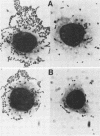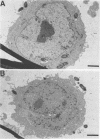Abstract
We designed experiments to assess the effect of chlorine injury on the virulence of waterborne enteropathogens. Higher chlorine doses (0.9 to 1.5 mg/liter) were necessary to produce injured Yersinia enterocolitica, Salmonella typhimurium, and Shigella spp. than to produce injured enterotoxigenic Escherichia coli or coliform bacteria (0.25 to 0.5 mg/liter) in the test system used; 50% lethal dose experiments in which mice were used showed that injured Y. enterocolitica cells were 20 times less virulent than uninjured control cells (3,300 and 160 CFU, respectively). This decrease in virulence was not related to reduced attachment to Henle 407 intestinal epithelial cells, but could be related to a loss of HeLa cell invasiveness. In contrast, injured S. typhimurium and enterotoxigenic E. coli cells lost their ability to attach to Henle cells. These data show that some enteropathogens and coliform bacteria differ in their sensitivities to chlorine injury and that the virulence determinants affected by chlorine may vary from one pathogen to another.
Full text
PDF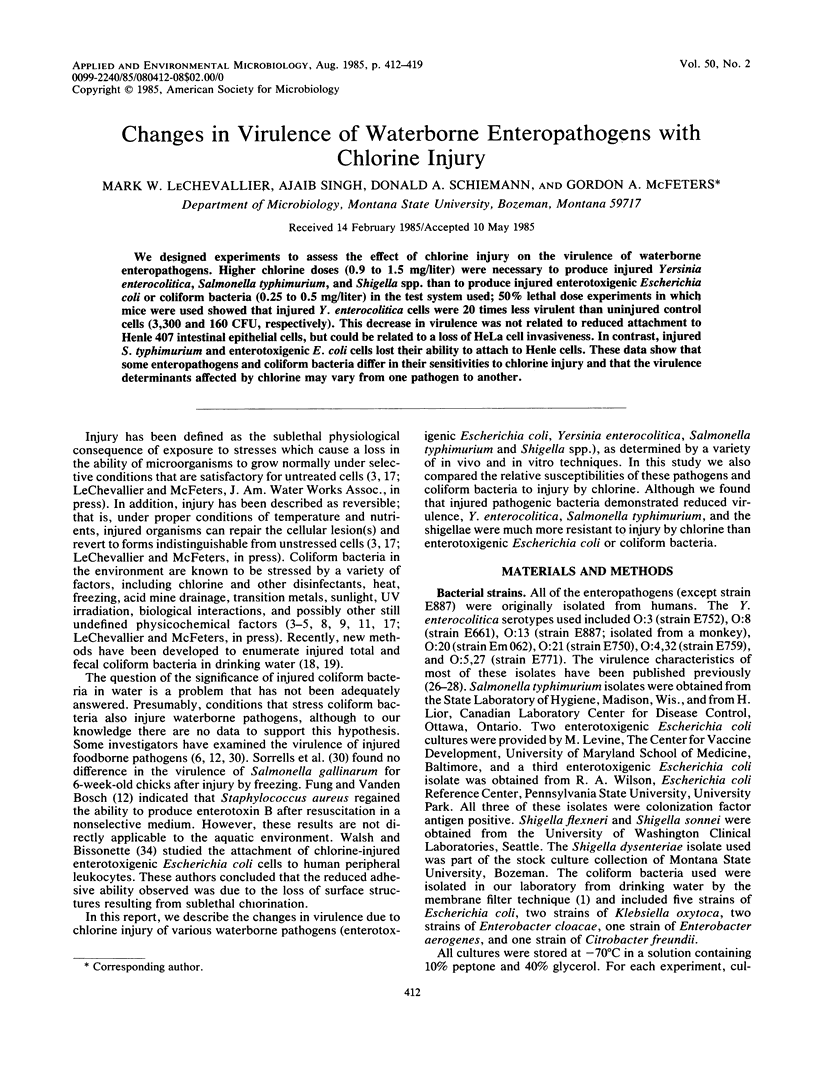
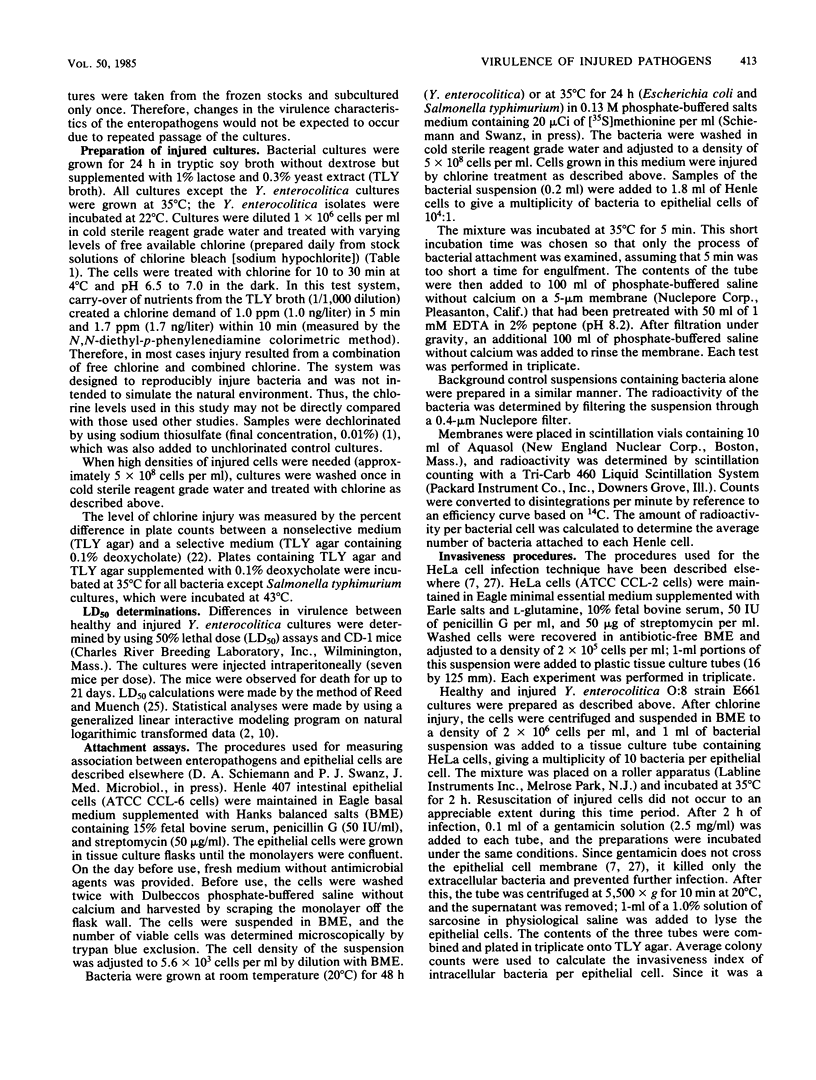
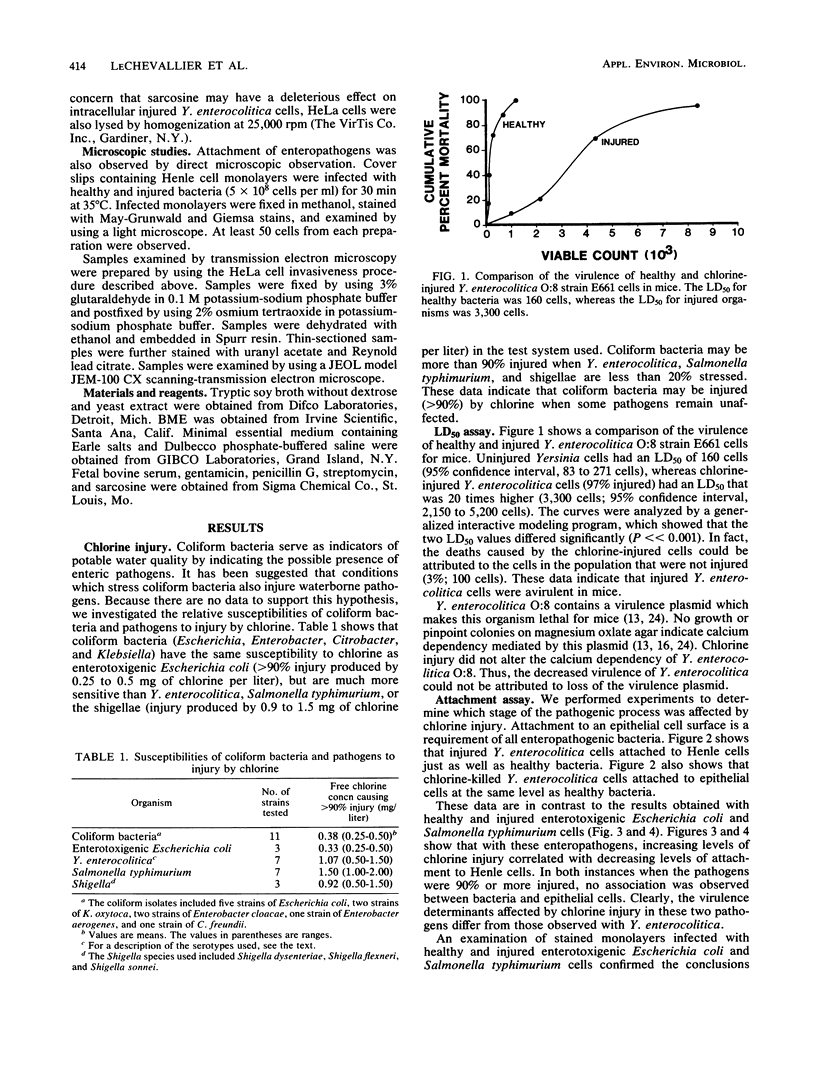
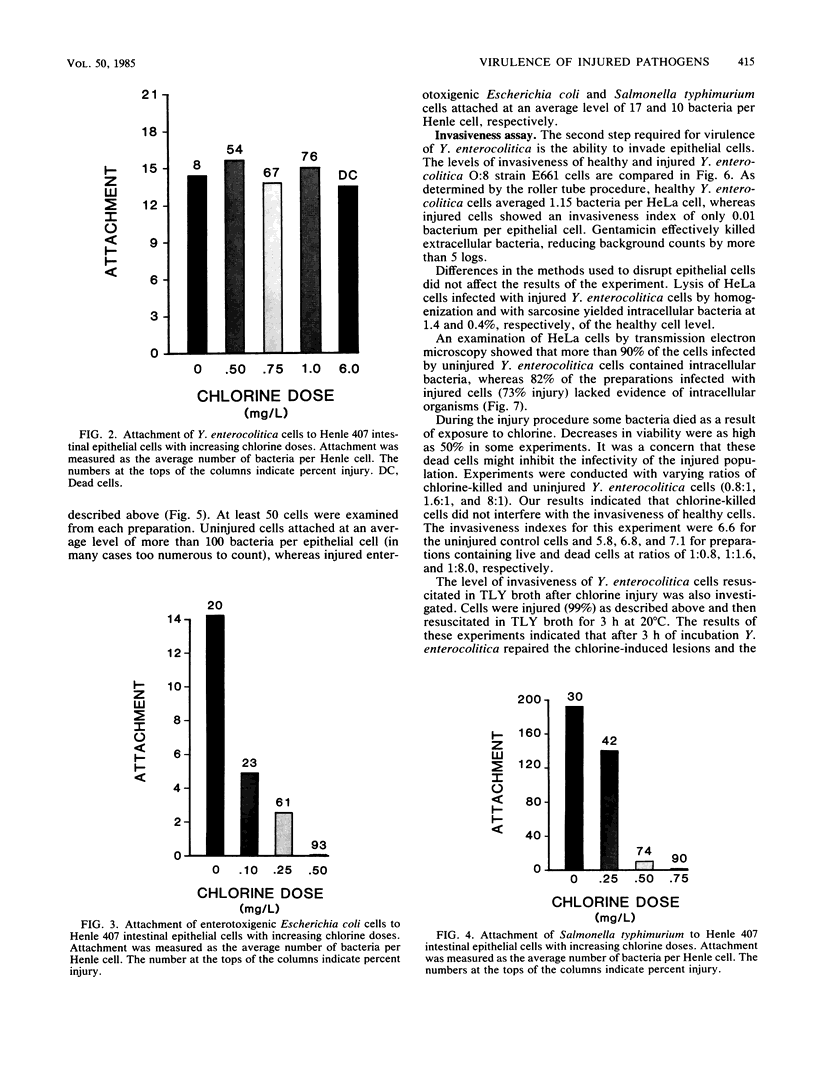
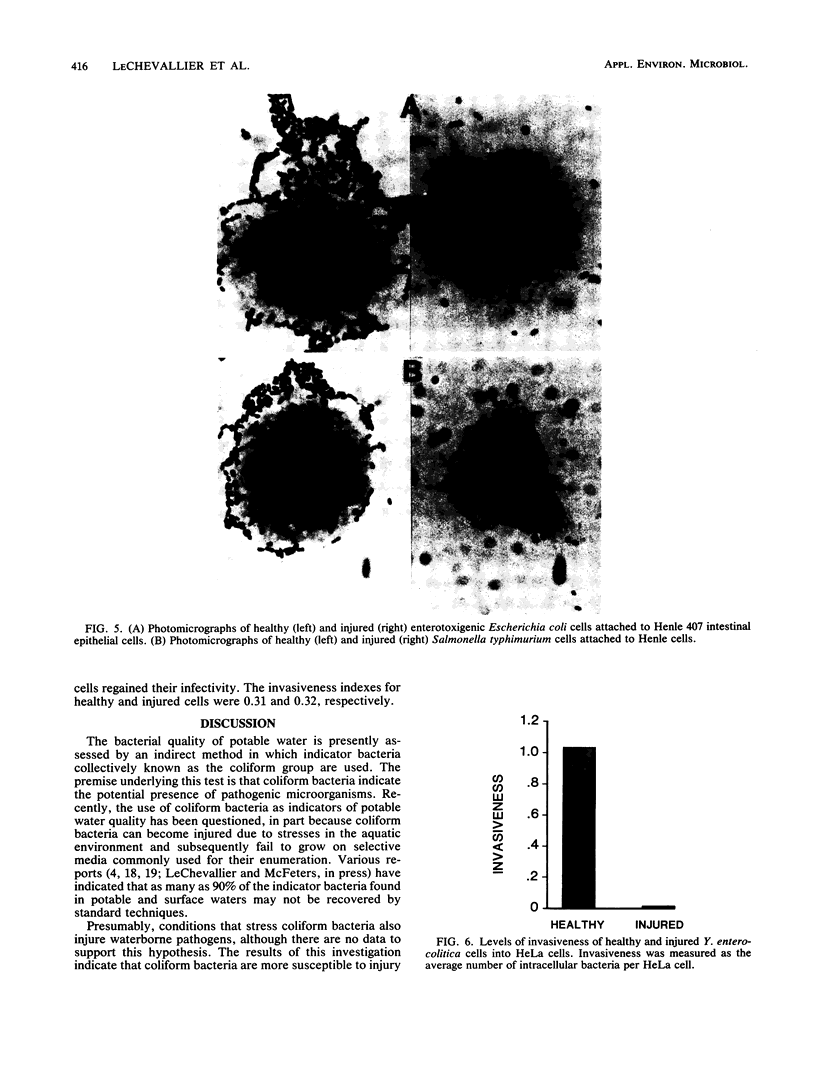

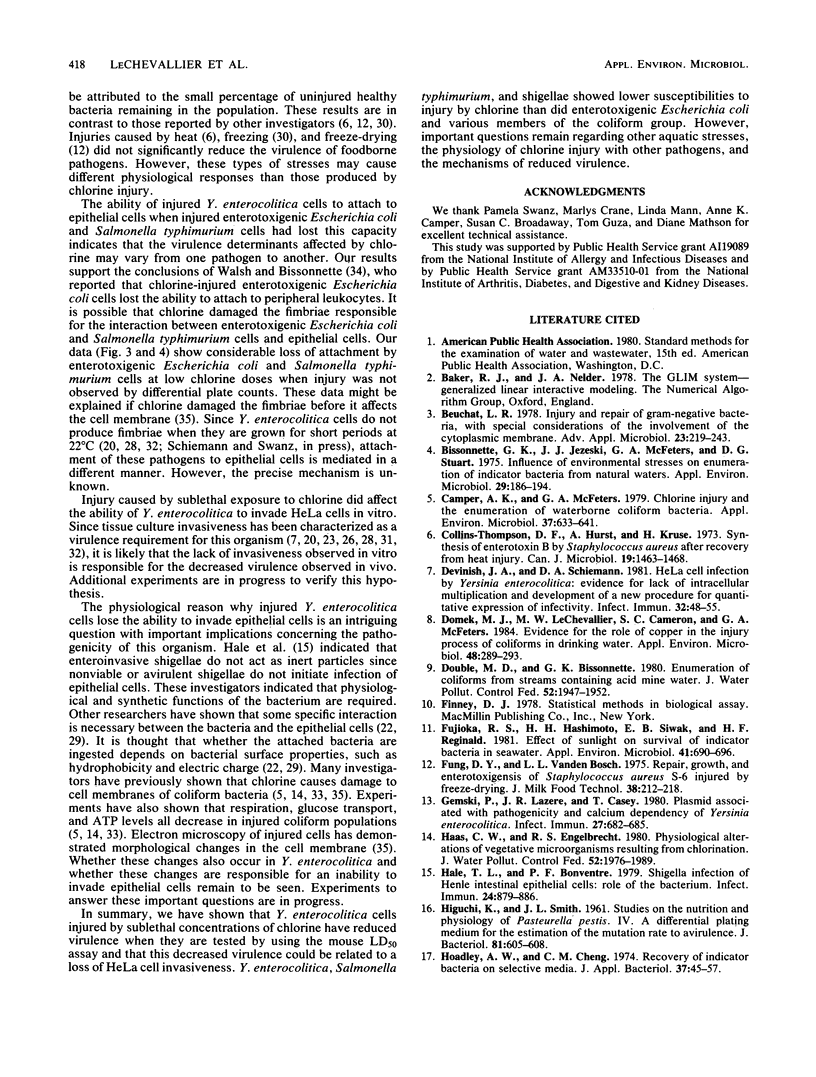
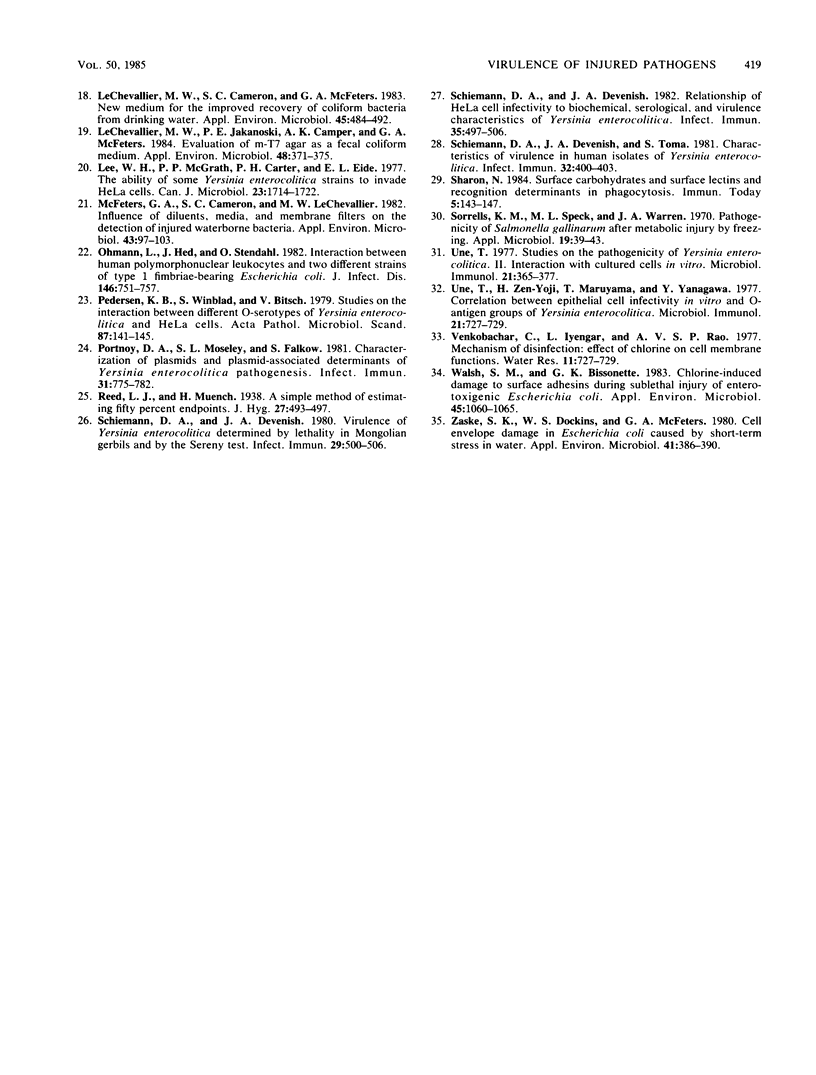
Images in this article
Selected References
These references are in PubMed. This may not be the complete list of references from this article.
- Beuchat L. R. Injury and repair of gram-negative bacteria, with special consideration of the involvement of the cytoplasmic membrane. Adv Appl Microbiol. 1978;23:219–243. doi: 10.1016/s0065-2164(08)70071-6. [DOI] [PubMed] [Google Scholar]
- Bissonnette G. K., Jezeski J. J., McFeters G. A., Stuart D. G. Influence of environmental stress on enumeration of indicator bacteria from natural waters. Appl Microbiol. 1975 Feb;29(2):186–194. doi: 10.1128/am.29.2.186-194.1975. [DOI] [PMC free article] [PubMed] [Google Scholar]
- Camper A. K., McFeters G. A. Chlorine injury and the enumeration of waterborne coliform bacteria. Appl Environ Microbiol. 1979 Mar;37(3):633–641. doi: 10.1128/aem.37.3.633-641.1979. [DOI] [PMC free article] [PubMed] [Google Scholar]
- Collins-Thompson D. L., Hurst A., Kruse H. Synthesis of enterotoxin B by Staphylococcus aureus strain S6 after recovery from heat injury. Can J Microbiol. 1973 Dec;19(12):1463–1468. doi: 10.1139/m73-238. [DOI] [PubMed] [Google Scholar]
- Devenish J. A., Schiemann D. A. HeLa cell infection by Yersinia enterocolitica: evidence for lack of intracellular multiplication and development of a new procedure for quantitative expression of infectivity. Infect Immun. 1981 Apr;32(1):48–55. doi: 10.1128/iai.32.1.48-55.1981. [DOI] [PMC free article] [PubMed] [Google Scholar]
- Domek M. J., LeChevallier M. W., Cameron S. C., McFeters G. A. Evidence for the role of copper in the injury process of coliform bacteria in drinking water. Appl Environ Microbiol. 1984 Aug;48(2):289–293. doi: 10.1128/aem.48.2.289-293.1984. [DOI] [PMC free article] [PubMed] [Google Scholar]
- Fujioka R. S., Hashimoto H. H., Siwak E. B., Young R. H. Effect of sunlight on survival of indicator bacteria in seawater. Appl Environ Microbiol. 1981 Mar;41(3):690–696. doi: 10.1128/aem.41.3.690-696.1981. [DOI] [PMC free article] [PubMed] [Google Scholar]
- Gemski P., Lazere J. R., Casey T. Plasmid associated with pathogenicity and calcium dependency of Yersinia enterocolitica. Infect Immun. 1980 Feb;27(2):682–685. doi: 10.1128/iai.27.2.682-685.1980. [DOI] [PMC free article] [PubMed] [Google Scholar]
- HIGUCHI K., SMITH J. L. Studies on the nutrition and physiology of Pasteurella pestis. VI. A differential plating medium for the estimation of the mutation rate to avirulence. J Bacteriol. 1961 Apr;81:605–608. doi: 10.1128/jb.81.4.605-608.1961. [DOI] [PMC free article] [PubMed] [Google Scholar]
- Haas C. N., Engelbrecht R. S. Physiological alterations of vegetative microorganisms resulting form chlorination. J Water Pollut Control Fed. 1980 Jul;52(7):1976–1989. [PubMed] [Google Scholar]
- Hale T. L., Bonventre P. F. Shigella infection of Henle intestinal epithelial cells: role of the bacterium. Infect Immun. 1979 Jun;24(3):879–886. doi: 10.1128/iai.24.3.879-886.1979. [DOI] [PMC free article] [PubMed] [Google Scholar]
- Hoadley A. W., Cheng C. M. The recovery of indicator bacteria on selective media. J Appl Bacteriol. 1974 Mar;37(1):45–57. doi: 10.1111/j.1365-2672.1974.tb00413.x. [DOI] [PubMed] [Google Scholar]
- LeChevallier M. W., Cameron S. C., McFeters G. A. New medium for improved recovery of coliform bacteria from drinking water. Appl Environ Microbiol. 1983 Feb;45(2):484–492. doi: 10.1128/aem.45.2.484-492.1983. [DOI] [PMC free article] [PubMed] [Google Scholar]
- LeChevallier M. W., Jakanoski P. E., Camper A. K., McFeters G. A. Evaluation of m-T7 agar as a fecal coliform medium. Appl Environ Microbiol. 1984 Aug;48(2):371–375. doi: 10.1128/aem.48.2.371-375.1984. [DOI] [PMC free article] [PubMed] [Google Scholar]
- Lee W. H., McGrath P. P., Carter P. H., Eide E. L. The ability of some Yersinia enterocolitica strains to invade HeLa cells. Can J Microbiol. 1977 Dec;23(12):1714–1722. doi: 10.1139/m77-247. [DOI] [PubMed] [Google Scholar]
- McFeters G. A., Cameron S. C., LeChevallier M. W. Influence of diluents, media, and membrane filters on detection fo injured waterborne coliform bacteria. Appl Environ Microbiol. 1982 Jan;43(1):97–103. doi: 10.1128/aem.43.1.97-103.1982. [DOI] [PMC free article] [PubMed] [Google Scholar]
- Ohman L., Hed J., Stendahl O. Interaction between human polymorphonuclear leukocytes and two different strains of type 1 fimbriae-bearing Escherichia coli. J Infect Dis. 1982 Dec;146(6):751–757. doi: 10.1093/infdis/146.6.751. [DOI] [PubMed] [Google Scholar]
- Pedersen K. B., Winblad S., Bitsch V. Studies on the interaction between different O-serotypes of Yersinia enterocolitica and HeLa cells. Acta Pathol Microbiol Scand B. 1979 Apr;87B(2):141–145. doi: 10.1111/j.1699-0463.1979.tb02417.x. [DOI] [PubMed] [Google Scholar]
- Portnoy D. A., Moseley S. L., Falkow S. Characterization of plasmids and plasmid-associated determinants of Yersinia enterocolitica pathogenesis. Infect Immun. 1981 Feb;31(2):775–782. doi: 10.1128/iai.31.2.775-782.1981. [DOI] [PMC free article] [PubMed] [Google Scholar]
- Schiemann D. A., Devenish J. A. Relationship of HeLa cell infectivity to biochemical, serological, and virulence characteristics of Yersinia enterocolitica. Infect Immun. 1982 Feb;35(2):497–506. doi: 10.1128/iai.35.2.497-506.1982. [DOI] [PMC free article] [PubMed] [Google Scholar]
- Schiemann D. A., Devenish J. A., Toma S. Characteristics of virulence in human isolates of Yersinia enterocolitica. Infect Immun. 1981 Apr;32(1):400–403. doi: 10.1128/iai.32.1.400-403.1981. [DOI] [PMC free article] [PubMed] [Google Scholar]
- Schiemann D. A., Devenish J. A. Virulence of Yersinia enterocolitica determined by lethality in Mongolian gerbils and by the Serény test. Infect Immun. 1980 Aug;29(2):500–506. doi: 10.1128/iai.29.2.500-506.1980. [DOI] [PMC free article] [PubMed] [Google Scholar]
- Sorrells K. M., Speck M. L., Warren J. A. Pathogenicity of Salmonella gallinarum after metabolic injury by freezing. Appl Microbiol. 1970 Jan;19(1):39–43. doi: 10.1128/am.19.1.39-43.1970. [DOI] [PMC free article] [PubMed] [Google Scholar]
- Une T. Studies on the pathogenicity of Yersinia enterocolitica. II. Interaction with cultured cells in vitro. Microbiol Immunol. 1977;21(7):365–377. doi: 10.1111/j.1348-0421.1977.tb00301.x. [DOI] [PubMed] [Google Scholar]
- Une T., Zen-Yoji H., Maruyama T., Yanagawa Y. Correlation between epithelial cell infectivity in vitro and O-antigen groups of Yersinia enterocolitica. Microbiol Immunol. 1977;21(12):727–729. doi: 10.1111/j.1348-0421.1977.tb00340.x. [DOI] [PubMed] [Google Scholar]
- Walsh S. M., Bissonnette G. K. Chlorine-induced damage to surface adhesions during sublethal injury of enterotoxigenic Escherichia coli. Appl Environ Microbiol. 1983 Mar;45(3):1060–1065. doi: 10.1128/aem.45.3.1060-1065.1983. [DOI] [PMC free article] [PubMed] [Google Scholar]
- Zaske S. K., Dockins W. S., McFeters G. A. Cell envelope damage in Escherichia coli caused by short-term stress in water. Appl Environ Microbiol. 1980 Aug;40(2):386–390. doi: 10.1128/aem.40.2.386-390.1980. [DOI] [PMC free article] [PubMed] [Google Scholar]



